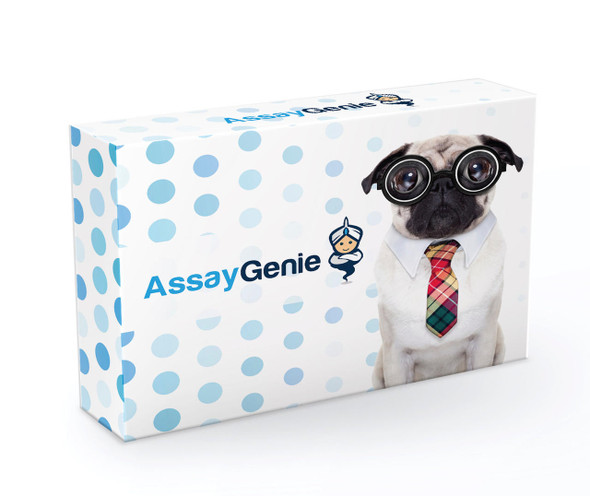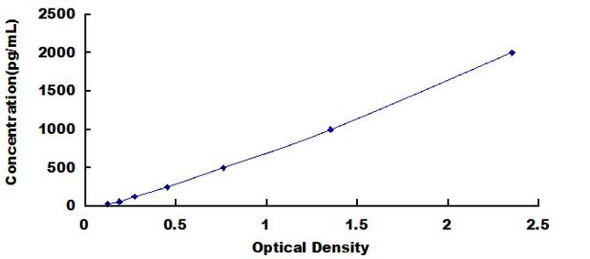Human AR (Amphiregulin) ELISA Kit (HUES01483)
- SKU:
- HUES01483
- Product Type:
- ELISA Kit
- Size:
- 96 Assays
- Uniprot:
- P15514
- Sensitivity:
- 18.75pg/mL
- Range:
- 31.25-2000pg/mL
- ELISA Type:
- Sandwich
- Synonyms:
- AREG, CRDGF, SDGF
- Reactivity:
- Human
- Sample Type:
- Serum, plasma and other biological fluids
- Research Area:
- Cell Biology
Description
Human AR (Amphiregulin) ELISA Kit
The Human AR (Amphiregulin) ELISA Kit is a powerful tool for measuring amphiregulin levels in human biological samples such as serum, plasma, and cell culture supernatants. With its high sensitivity and specificity, this kit provides accurate and reliable results, making it suitable for a wide range of research applications.Amphiregulin is a key growth factor that plays a critical role in cell proliferation, differentiation, and tissue repair. Its dysregulation has been implicated in various diseases, including cancer, inflammatory disorders, and tissue damage.
As a result, the Human AR ELISA Kit is an essential tool for studying the biology of amphiregulin and its potential implications in disease mechanisms and therapeutic interventions.Get your Human AR ELISA Kit today and unlock the potential of amphiregulin research in advancing our understanding of human health and disease. Visit our website for more information and to place your order.
| Assay type: | Sandwich |
| Format: | 96T |
| Assay time: | 4.5h |
| Reactivity: | Human |
| Detection Method: | Colormetric |
| Detection Range: | 31.25-2000 pg/mL |
| Sensitivity: | 18.75 pg/mL |
| Sample Volume Required Per Well: | 100µL |
| Sample Type: | Serum, plasma and other biological fluids |
| Specificity: | This kit recognizes Human AR in samples. No significant cross-reactivity or interference between Human AR and analogues was observed. |
This ELISA kit uses Sandwich-ELISA as the method. The micro ELISA plate provided in this kit has been pre-coated with an antibody specific to Human AR. Standards or samples are added to the appropriate micro ELISA plate wells and combined with the specific antibody. Then a biotinylated detection antibody specific for Human AR and Avidin-Horseradish Peroxidase (HRP) conjugate are added to each micro plate well successively and incubated. Free components are washed away. The substrate solution is added to each well. Only those wells that contain Human AR, biotinylated detection antibody and Avidin-HRP conjugate will appear blue in color. The enzyme-substrate reaction is terminated by adding Stop Solution and the color turns yellow. The optical density (OD) is measured spectrophotometrically at a wavelength of 450 nm ± 2 nm. The OD value is proportional to the concentration of Human AR. The concentration of Human AR in samples can be calculated by comparing the OD of the samples to the standard curve.
| UniProt Protein Function: | AREG: Ligand of the EGF receptor/EGFR. Autocrine growth factor as well as a mitogen for a broad range of target cells including astrocytes, Schwann cells and fibroblasts. Belongs to the amphiregulin family. |
| UniProt Protein Details: | Protein type:Membrane protein, integral Chromosomal Location of Human Ortholog: 4q13. 3 Cellular Component: extracellular space; cell surface; cytoplasm; integral to membrane; nucleus Molecular Function:protein binding; growth factor activity; cytokine activity; epidermal growth factor receptor binding Biological Process: epidermal growth factor receptor signaling pathway; response to peptide hormone stimulus; response to cAMP; response to glucocorticoid stimulus; response to estradiol stimulus; glial cell proliferation; cell proliferation; G-protein coupled receptor protein signaling pathway; cell-cell signaling; response to hydrogen peroxide; positive regulation of cell proliferation; negative regulation of osteoblast differentiation; neurite development; positive regulation of phosphorylation; positive regulation of DNA replication |
| NCBI Summary: | The protein encoded by this gene is a member of the epidermal growth factor family. It is an autocrine growth factor as well as a mitogen for astrocytes, Schwann cells and fibroblasts. It is related to epidermal growth factor (EGF) and transforming growth factor alpha (TGF-alpha). The protein interacts with the EGF/TGF-alpha receptor to promote the growth of normal epithelial cells, and it inhibits the growth of certain aggressive carcinoma cell lines. It also functions in mammary gland, oocyte and bone tissue development. This gene is associated with a psoriasis-like skin phenotype, and is also associated with other pathological disorders, including various types of cancers and inflammatory conditions. [provided by RefSeq, Apr 2014] |
| UniProt Code: | P15514 |
| NCBI GenInfo Identifier: | 113754 |
| NCBI Gene ID: | 374 |
| NCBI Accession: | P15514. 2 |
| UniProt Secondary Accession: | P15514,Q5U026, |
| UniProt Related Accession: | P15514 |
| Molecular Weight: | 27,895 Da |
| NCBI Full Name: | Amphiregulin |
| NCBI Synonym Full Names: | amphiregulin |
| NCBI Official Symbol: | AREG |
| NCBI Official Synonym Symbols: | AR; SDGF; AREGB; CRDGF |
| NCBI Protein Information: | amphiregulin; amphiregulin B; schwannoma-derived growth factor; colorectum cell-derived growth factor |
| UniProt Protein Name: | Amphiregulin |
| UniProt Synonym Protein Names: | Colorectum cell-derived growth factor; CRDGF |
| Protein Family: | Amphiregulin |
| UniProt Gene Name: | AREG |
| UniProt Entry Name: | AREG_HUMAN |
As the OD values of the standard curve may vary according to the conditions of the actual assay performance (e. g. operator, pipetting technique, washing technique or temperature effects), the operator should establish a standard curve for each test. Typical standard curve and data is provided below for reference only.
| Concentration (pg/mL) | O.D | Average | Corrected |
| 2000 | 2.315 2.373 | 2.344 | 2.276 |
| 1000 | 1.618 1.662 | 1.64 | 1.572 |
| 500 | 0.938 0.926 | 0.932 | 0.864 |
| 250 | 0.507 0.525 | 0.516 | 0.448 |
| 125 | 0.276 0.27 | 0.273 | 0.205 |
| 62.5 | 0.179 0.159 | 0.169 | 0.101 |
| 31.25 | 0.116 0.124 | 0.12 | 0.052 |
| 0 | 0.06 0.076 | 0.068 | -- |
Precision
Intra-assay Precision (Precision within an assay): 3 samples with low, mid range and high level Human AR were tested 20 times on one plate, respectively.
Inter-assay Precision (Precision between assays): 3 samples with low, mid range and high level Human AR were tested on 3 different plates, 20 replicates in each plate.
| Intra-assay Precision | Inter-assay Precision | |||||
| Sample | 1 | 2 | 3 | 1 | 2 | 3 |
| n | 20 | 20 | 20 | 20 | 20 | 20 |
| Mean (pg/mL) | 92.20 | 262.76 | 704.07 | 96.85 | 284.90 | 673.05 |
| Standard deviation | 5.81 | 12.03 | 37.53 | 5.45 | 14.62 | 29.61 |
| C V (%) | 6.30 | 4.58 | 5.33 | 5.63 | 5.13 | 4.40 |
Recovery
The recovery of Human AR spiked at three different levels in samples throughout the range of the assay was evaluated in various matrices.
| Sample Type | Range (%) | Average Recovery (%) |
| Serum (n=5) | 93-109 | 99 |
| EDTA plasma (n=5) | 93-106 | 98 |
| Cell culture media (n=5) | 85-97 | 92 |
Linearity
Samples were spiked with high concentrations of Human AR and diluted with Reference Standard & Sample Diluent to produce samples with values within the range of the assay.
| Serum (n=5) | EDTA plasma (n=5) | Cell culture media (n=5) | ||
| 1:2 | Range (%) | 99-113 | 98-111 | 85-97 |
| Average (%) | 106 | 104 | 92 | |
| 1:4 | Range (%) | 92-107 | 79-93 | 83-97 |
| Average (%) | 99 | 86 | 90 | |
| 1:8 | Range (%) | 88-100 | 80-93 | 83-94 |
| Average (%) | 94 | 85 | 89 | |
| 1:16 | Range (%) | 91-108 | 84-98 | 85-98 |
| Average (%) | 99 | 91 | 90 |
An unopened kit can be stored at 4°C for 1 month. If the kit is not used within 1 month, store the items separately according to the following conditions once the kit is received.
| Item | Specifications | Storage |
| Micro ELISA Plate(Dismountable) | 8 wells ×12 strips | -20°C, 6 months |
| Reference Standard | 2 vials | |
| Concentrated Biotinylated Detection Ab (100×) | 1 vial, 120 µL | |
| Concentrated HRP Conjugate (100×) | 1 vial, 120 µL | -20°C(shading light), 6 months |
| Reference Standard & Sample Diluent | 1 vial, 20 mL | 4°C, 6 months |
| Biotinylated Detection Ab Diluent | 1 vial, 14 mL | |
| HRP Conjugate Diluent | 1 vial, 14 mL | |
| Concentrated Wash Buffer (25×) | 1 vial, 30 mL | |
| Substrate Reagent | 1 vial, 10 mL | 4°C(shading light) |
| Stop Solution | 1 vial, 10 mL | 4°C |
| Plate Sealer | 5 pieces | |
| Product Description | 1 copy | |
| Certificate of Analysis | 1 copy |
- Set standard, test sample and control (zero) wells on the pre-coated plate and record theirpositions. It is recommended to measure each standard and sample in duplicate. Note: addall solutions to the bottom of the plate wells while avoiding contact with the well walls. Ensuresolutions do not foam when adding to the wells.
- Aliquot 100 µL of standard solutions into the standard wells.
- Add 100 µL of Sample / Standard dilution buffer into the control (zero) well.
- Add 100 µL of properly diluted sample (serum, plasma, tissue homogenates and otherbiological fluids) into test sample wells.
- Cover the plate with the sealer provided in the kit and incubate for 90 min at 37 °C.
- Aspirate the liquid from each well, do not wash. Immediately add 100 µL of BiotinylatedDetection Ab working solution to each well. Cover the plate with a plate seal and gently mix. Incubate for 1 hour at 37 °C.
- Aspirate or decant the solution from the plate and add 350 µL of wash buffer to each welland incubate for 1-2 minutes at room temperature. Aspirate the solution from each well andclap the plate on absorbent filter paper to dry. Repeat this process 3 times. Note: a microplatewasher can be used in this step and other wash steps.
- Add 100 µL of HRP Conjugate working solution to each well. Cover with a plate seal andincubate for 30 min at 37 °C.
- Aspirate or decant the solution from each well. Repeat the wash process for five times asconducted in step 7.
- Add 90 µL of Substrate Reagent to each well. Cover with a new plate seal and incubate forapproximately 15 min at 37 °C. Protect the plate from light. Note: the reaction time can beshortened or extended according to the actual color change, but not by more than 30min.
- Add 50 µL of Stop Solution to each well. Note: Adding the stop solution should be done inthe same order as the substrate solution.
- Determine the optical density (OD value) of each well immediately with a microplate readerset at 450 nm.







